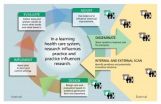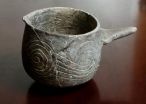(Press-News.org) PHILADELPHIA – Bioengineered replacements for tendons, ligaments, the meniscus of the knee, and other tissues require re-creation of the exquisite architecture of these tissues in three dimensions. These fibrous, collagen-based tissues located throughout the body have an ordered structure that gives them their robust ability to bear extreme mechanical loading.
Many labs have been designing treatments for ACL and meniscus tears of the knee, rotator cuff injuries, and Achilles tendon ruptures for patients ranging from the weekend warrior to the elite Olympian. One popular approach has involved the use of scaffolds made from nano-sized fibers, which can guide tissue to grow in an organized way. Unfortunately, the fibers' widespread application in orthopaedics has been slowed because cells do not readily colonize the scaffolds if fibers are too tightly packed.
Robert L. Mauck, PhD, professor of Orthopaedic Surgery and Bioengineering, and Brendon M. Baker, PhD, previously a graduate student in the Mauck lab at the Perelman School of Medicine, University of Pennsylvania, have developed and validated a new technology in which composite nanofibrous scaffolds provide a loose enough structure for cells to colonize without impediment, but still can instruct cells how to lay down new tissue. Their findings appear online this week in the Proceedings of the National Academy of Sciences.
"These are tiny fibers with a huge potential that can be unlocked by including a temporary, space-holding element," says Mauck. The fibers are on the order of nanometers in diameter. A nanometer is a billionth of a meter.
Using a method that has been around since the 1930s called electrospinning, the team made composites containing two distinct fiber types: a slow-degrading polymer and a water-soluble polymer that can be selectively removed to increase or decrease the spacing between fibers. The fibers are made by electrically charging solutions of dissolved polymers, causing the solution to erupt as a fine spray of fibers which fall like snow onto a rotating drum and collect as a stretchable fabric. This textile can then be shaped for medical applications and cells can be added, or it can be implanted directly -- as a patch of sorts -- into damaged tissue for neighboring cells to colonize.
Increasing the proportion of the dissolving fibers enhanced the ability of host cells to colonize the nanofiber mesh and eventually migrate to achieve a uniform distribution and form a truly three- dimensional tissue. Despite the removal of more than 50 percent of the initial fibers, the remaining scaffold was a sufficient architecture to align cells and direct the formation of a highly organized extracellular matrix by collagen-producing cells. This, in turn, led to a biologic material with tensile properties nearly matching human meniscus tissue, in lab tests of tissue mechanics.
"This approach transforms what was once an interesting biomaterials phenomenon -- cells on the surface of nanofibrous mats -- into a method by which functional, three-dimensional tissues can be formed," says Mauck.
It is a marked step forward in the engineering of load-bearing fibrous tissues, and will eventually find widespread applications in regenerative medicine, say the authors.
Mauck and his team are currently testing these novel materials in a large animal model of meniscus repair and for other orthopaedic applications.
INFORMATION:
Co-authors are Roshan P. Shah, Amy M. Silverstein, and Jason A. Burdick, all from Penn, and John L. Esterhai, from the Philadelphia VA Medical Center.
This work was supported by National Institutes of Health Grant R01 AR056624 from the National Institute of Arthritis and Musculoskeletal and Skin Diseases and a Department of Veterans Affairs Grant I01 RX000174.
Penn Medicine is one of the world's leading academic medical centers,
dedicated to the related missions of medical education, biomedical
research, and excellence in patient care. Penn Medicine consists of the
Raymond and Ruth Perelman School of Medicine at the University of
Pennsylvania (founded in 1765 as the nation's first medical school) and
the University of Pennsylvania Health System, which together form a $4.3
billion enterprise.
The Perelman School of Medicine is currently ranked #2 in U.S. News &
World Report's survey of research-oriented medical schools. The School
is consistently among the nation's top recipients of funding from the
National Institutes of Health, with $479.3 million awarded in the 2011
fiscal year.
The University of Pennsylvania Health System's patient care facilities
include: The Hospital of the University of Pennsylvania -- recognized as
one of the nation's top "Honor Roll" hospitals by U.S. News & World
Report; Penn Presbyterian Medical Center; and Pennsylvania Hospital -
the nation's first hospital, founded in 1751. Penn Medicine also
includes additional patient care facilities and services throughout the
Philadelphia region.
Penn Medicine is committed to improving lives and health through a
variety of community-based programs and activities. In fiscal year 2011,
Penn Medicine provided $854 million to benefit our community.
Composite nanofibers developed by Penn scientists next chapter in orthopaedic biomaterials
2012-08-07
ELSE PRESS RELEASES FROM THIS DATE:
California's hydroelectricity production is vulnerable to climate change
2012-08-07
RIVERSIDE, Calif. — California's hydropower is vulnerable to climate change, a University of California, Riverside scientist has advised policymakers in "Our Changing Climate," a report released July 31 by the California Natural Resources Agency and the California Energy Commission (CEC).
"Climate change is expected to affect the quantity and timing of water flow in the state," explained Kaveh Madani, a former postdoctoral research scholar in UC Riverside's Water Science and Policy Center (WSPC), who led a research project on climate change effects on hydropower production, ...
Annals of Internal Medicine tip sheet for Aug. 7, 2012 issue
2012-08-07
1. Tuning into Contextual Clues May Help Doctors Improve Antibiotic Prescribing Habits
Appropriate use of antibiotics can improve patient outcomes and reduce risk for antibiotic resistance. Febrile respiratory illnesses, or FRI, often present with vague, cold-like symptoms, making it difficult to discern whether the illness is viral or bacterial. Since there are few bedside clues that reliably distinguish viral from bacterial, physicians rely on contextual factors to aid treatment decisions. Contextual factors include epidemiology (for example, flu pandemic period) and ...
Fainting: All in the family?
2012-08-07
MINNEAPOLIS – Fainting has a strong genetic predisposition, according to new research published in the August 7, 2012, print issue of Neurology®, the medical journal of the American Academy of Neurology. Fainting, also called vasovagal syncope, is a brief loss of consciousness when your body reacts to certain triggers, such as emotional distress or the sight of blood.
"The question of whether fainting is caused by genetic factors, environmental factors or a mixture of both has been the subject of debate," said study author Samuel F. Berkovic, MD, FRS, with the University ...
A 'learning health system' moves from idea to action
2012-08-07
In the United States, clinicians are struggling to provide better and more affordable health care to more people—while keeping up with new scientific developments. The idea of a "learning health system" is one proposed solution for rapidly applying the best available scientific evidence in real-time clinical practice. In the August 7 Annals of Internal Medicine, a Group Health Cooperative team describes the experience of turning this intriguing concept into action.
"In a learning health system, evidence and practice come together in a virtuous cycle, influencing each ...
Researchers peek at the early evolution of sex chromosomes
2012-08-07
CHAMPAIGN, Ill. — Two new studies offer insight into sex chromosome evolution by focusing on papaya, a multimillion dollar crop plant with a sexual problem (as far as growers are concerned) and a complicated past. The findings are described in two papers in the Proceedings of the National Academy of Sciences.
The research reveals that the papaya sex chromosomes have undergone dramatic changes in their short evolutionary histories (they are about 7 million years old; by comparison, human sex chromosomes began their evolution more than 167 million years ago). One of the ...
Researchers find evidence of ritual use of 'black drink' at Cahokia
2012-08-07
CHAMPAIGN, Ill. — People living 700 to 900 years ago in Cahokia, a massive settlement near the confluence of the Missouri and Mississippi Rivers, ritually used a caffeinated brew made from the leaves of a holly tree that grew hundreds of miles away, researchers report.
The discovery – made by analyzing plant residues in pottery beakers from Cahokia and its surroundings – is the earliest known use of this "black drink" in North America. It pushes back the date by at least 500 years, and adds to the evidence that a broad cultural and trade network thrived in the Midwest ...
Generic language helps fuel stereotypes, NYU, Princeton researchers find
2012-08-07
Hearing generic language to describe a category of people, such as "boys have short hair," can lead children to endorse a range of other stereotypes about the category, a study by researchers at New York University and Princeton University has found. Their research, which appears in the Proceedings of the National Academy of Sciences (PNAS), also points to more effective methods to reduce stereotyping and prejudice.
The study focused on "social essentialism," or the belief that certain social categories, such as race or gender, mark fundamentally distinct kinds of people. ...
Gladstone scientists discover that epilepsy drug reverses memory loss in animal model of AD
2012-08-07
SAN FRANCISCO, CA—August 6, 2012— Scientists at the Gladstone Institutes have discovered that an FDA-approved anti-epileptic drug reverses memory loss and alleviates other Alzheimer's-related impairments in an animal model of the disease.
Scientists in the laboratory of Lennart Mucke, MD, who directs neurological research at Gladstone, conducted the research on mice genetically modified to simulate key aspects of Alzheimer's disease. In the study, they show how levetiracetam—a drug commonly prescribed for patients who suffer from epilepsy—suppresses abnormal brain activity ...
New genetic study defines the genetic map of the Jewish Diasporas
2012-08-07
VIDEO:
Harry Ostrer, M.D., discusses how his research into a new genetic analysis focusing on Jews from North Africa has provided an overall genetic map of the Jewish Diasporas. Dr....
Click here for more information.
August 6, 2012 — (Bronx, NY) — A new genetic analysis focusing on Jews from North Africa has provided an overall genetic map of the Jewish Diasporas. The findings support the historical record of Middle Eastern Jews settling in North Africa during Classical Antiquity, ...
Behavioral intervention can reduce tics in adults with Tourette syndrome
2012-08-07
Specially designed comprehensive behavioral therapy is more effective than sessions offering patient support and education in helping adults with Tourette syndrome manage their tics – sudden, repetitive motions or vocalizations – according to a study in the August issue of Archives of General Psychiatry. The findings come from a team of investigators at Massachusetts General Hospital (MGH)/Harvard Medical School, Yale University, the University of Texas Health Science Center at San Antonio, and other institutions.
"The program we tested, which teaches patients new ways ...




